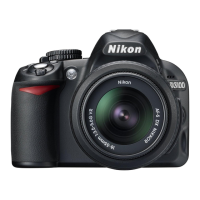179
n
Caring for the Camera
Storage
When the camera will not be used for an extended period, remove the battery and
store it in a cool, dry area with the terminal cover in place.
To prevent mold or
mildew, store the camera in a dry, well-ventilated area.
Do not store your camera
with naphtha or camphor moth balls or in locations that:
• are poorly ventilated or subject to humidities of over 60%
• are next to equipment that produces strong electromagnetic fields, such as
televisions or radios
• are exposed to temperatures above 50 °C (122 °F) or below –10 °C (14 °F)
Cleaning
Do not use alcohol, thinner, or other volatile chemicals.
Camera
body
Use a blower to remove dust and lint, then wipe gently with a soft, dry cloth.
After
using the camera at the beach or seaside, wipe off sand or salt with a cloth lightly
dampened in distilled water and dry thoroughly.
Important: Dust or other foreign
matter inside the camera may cause damage not covered under warranty.
Lens,
mirror, and
viewfinder
These glass elements are easily damaged.
Remove dust and lint with a blower.
If
using an aerosol blower, keep the can vertical to prevent the discharge of liquid.
To
remove fingerprints and other stains, apply a small amount of lens cleaner to a soft
cloth and clean with care.
Monitor
Remove dust and lint with a blower.
When removing fingerprints and other stains,
wipe the surface lightly with a soft cloth or chamois leather.
Do not apply pressure,
as this could result in damage or malfunction.
D Servicing the Camera and Accessories
The camera is a precision device and requires regular servicing.
Nikon recommends that the
camera be inspected by the original retailer or Nikon-authorized service representative once
every one to two years, and that it be serviced once every three to five years (note that fees
apply to these services).
Frequent inspection and servicing are particularly recommended if
the camera is used professionally.
Any accessories regularly used with the camera, such as
lenses or optional flash units, should be included when the camera is inspected or serviced.

